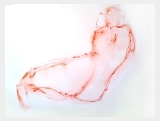People often say they find life drawing very calming and even meditative. As one model said, "When I am there everything just stops," and people who draw often say appreciatively that everything else goes away at the time, even in the midst of a busy life. Models often feel rested and refreshed afterwards, and drawers find the world looks brighter and clearer. Now why is that?
Actually sitting still and silently contemplating an object such as a candle, rock, or flower is a classic meditation exercise, and so too is just being there, with eyes open or closed, bringing one's attention to the breath or a part of the body and keeping it there. It's like doing nothing. Doing this usually calms the mind and gives more focus and concentration afterwards. So what is meditation?
Meditation is breathing, and we can all do it. As one great teacher said, to do meditation you need two things: a body and a mind. When you just sit, or lie, or stand still and watch your breath go in and out, you can feel the breath and see thoughts arise and chase one another busily about the place. Isn't it tiring trying to keep up, and how many thoughts do you have in a day? Supposing you did not follow those thoughts around, but let them quietly calm down and even have a few less of them crowding round? Now that would be peaceful and restful.
But suppose that thoughts do not always want to calm down and the mind is actually like a naughty monkey, always chattering and leaping from tree to tree merrily making mischief. How do you stop that? Well a tranquilising dart might do it temporarily, but to do it without medication, meditation is the method and develops what is called mindfulness. As does drawing from observation.
Are thoughts enemies you need to wrestle down? Are they friends you need to greet by jumping up and making cups of tea? Let them go, you don't have to react, just let go. Let the thoughts go. You can look at them kindly, like watching wild animals come to drink at a quiet forest pool before they slip away again.
When modelling bringing your attention to the breath or a particular body part such as the end of your nose can be a very helpful way to deal with discomfort or unwelcome bodily sensations. One technique is to systematically move the attention around the body, scanning each part and moving on to the next. Another is to focus the eyes on a single point and not move them, gradually letting the gaze go soft.
What is your breath like? Is it fast? Slow? Are you pushing it in and out and holding on to it tightly? Do you really need to do that? Can you let your breath get softer?
What is in your mind when it is empty? You are.

